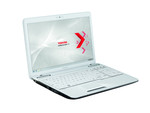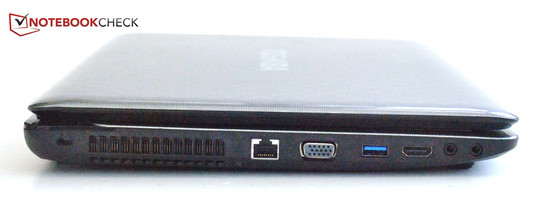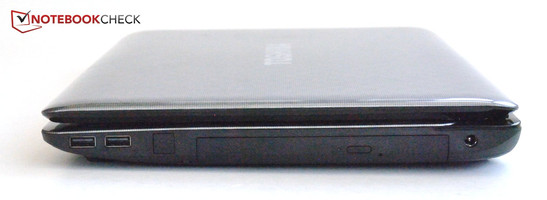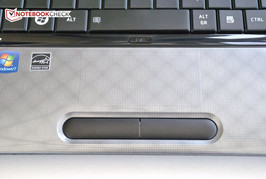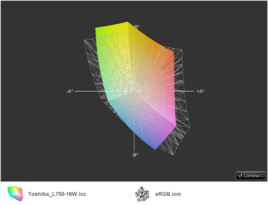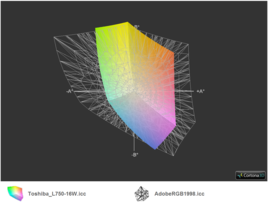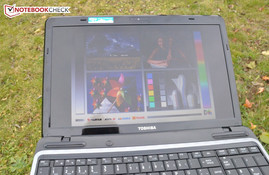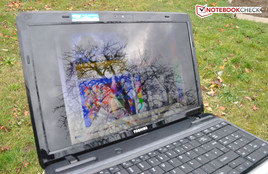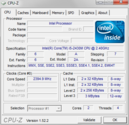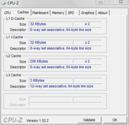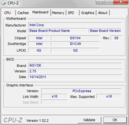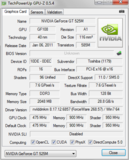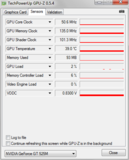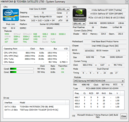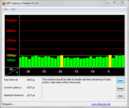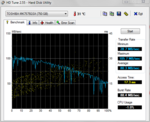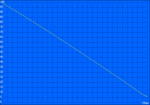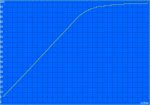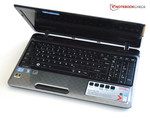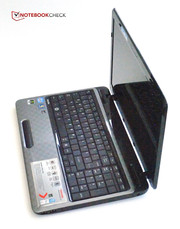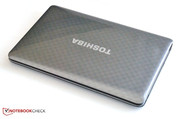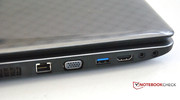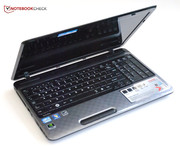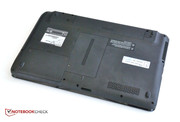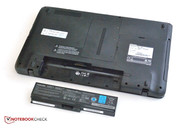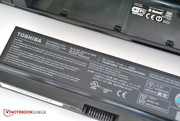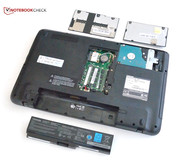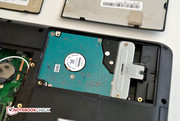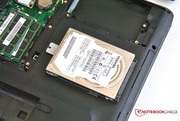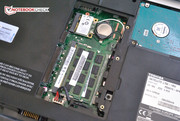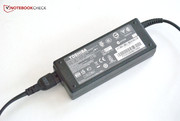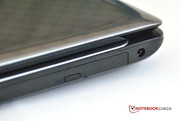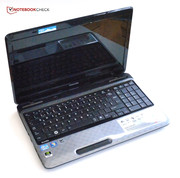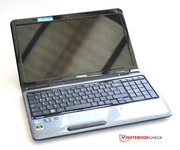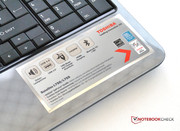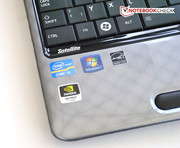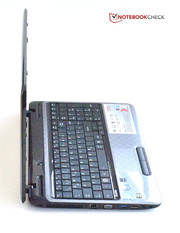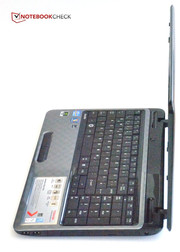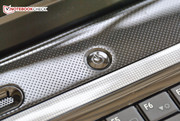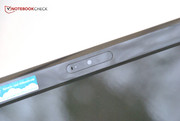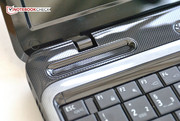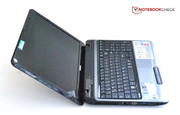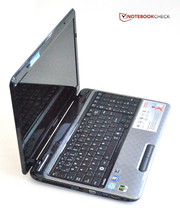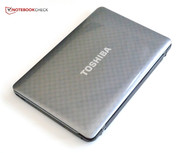Review Toshiba Satellite L750-16W Notebook
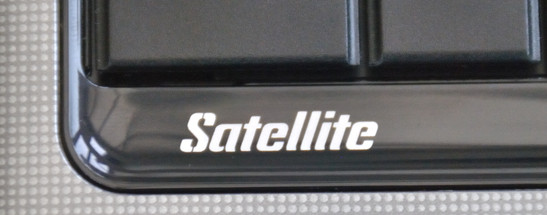
Toshiba's Satellite L750 range clearly targets private customers. Toshiba advertises it as a stylish design piece for little money. However, the buyer's wallet shouldn't be too small either. The L750-16W costs €700 and if the Satellite will be seen as a design piece lies in the eye of the beholder.
The specifications give hope for good performance: A new Intel Core i5 and the Nvidia GeForce GT 525M are built in as key components. The Satellite L755 is identical to the Satellite L750 range, but the latter has a superior configuration and also a higher price.
Case
The Toshiba L750-16W will be available in a gray-black design in stores. The display lid and the wrist rest are made of light gray, glossy plastic. There are different sized, bright dots on it, which merge to a diamond pattern when looking at it from a distance.
The Satellite L750/L755 series is also available in black, white, red and chestnut brown. We have a Satellite L750 in zinc gray in review.
The display lid is made of glossy, black plastic just like the loudspeaker bar, and the gray dots are also found here. The bottom is made of black plastic and has two maintenance covers.
All corners and edges of the laptop are rounded. Users who want to maintain the surface shine will have to polish the many glossy surfaces often. Greasy stains and fingerprints also become quickly visible on the plastic.
The Satellite is remarkably rigid. The display lid can be dent clearly, but no color distortions are passed on to the screen. The hinges are strong and have a good grip on the screen. But the base unit has to be held down to open the laptop because it would otherwise lift up along.
The area of the optical drive can be dented a bit on the bottom. The rest of the notebook hardly yields. The area between the keyboard and display seem particularly stable. The base unit can't be warped and doesn't emit any creaking noises.
Connectivity
The Satellite isn't especially well equipped, but no particularly vital ports have been omitted either. The power socket is located on the rear right. It is followed by the DVD drive and two USB 2.0 ports. Between these there is a flap for a modem socket on the expensive models.
The rear doesn't have any interfaces. The 5in1 card reader, for MMC, MS/MS-PRO, SD and SDHC, is on the front.
The mandatory Kensington lock is found on the rear left. That is followed by the vents and the Gigabit LAN socket. The VGA and HDMI ports are also found on the left front. A USB 3.0 port with charge function has been placed between that. Headphones and microphone can also be connected on the left front.
Toshiba hasn't done a good job with the interface positioning. All ports are located on the front area of the sides. Consequently, the room beside the notebook is very limited when the ports are used.
Communication
As usual, the network technology WLAN b/g/n and Gigabit LAN are on board. Apart from that, a few devices can also be connected to the notebook via the built-in Bluetooth 3.0 +HS. On the right, there is a symbol for a modem socket beside a flap. But it isn't installed into this model.
Software
Toshiba has equipped the Satellite generously with software. Besides the known Microsoft Office Starter, McAfee and Nero 10, Toshiba also installs its own programs. There are more or less useless programs among them, such as Toshiba's energy management and face recognition software. Its error rate is high and a lot of patience is needed to log-on under Windows 7.
Warranty
The warranty includes a 2 year onsite pick-up service in Germany and Austria. The notebook has to be sent to a Toshiba Service Center from all other countries. The pick-up service isn't a matter of course in the consumer range. The warranty can be extended for dealer-specific surcharges.
Input Devices
Keyboard
The built-in keyboard is made of rectangular keys that have been beveled on their edges. The arrow keys are separated from the rest of the keyboard, but aren't quite as long as the other keys. The keyboard is surrounded by a high gloss bezel which quickly smudges. The keys can score with a clear pressure point and feedback. Every now and again two keys are pressed simultaneously due to the small gap between the keys.
A numpad is located beside the QWERTY keyboard. It facilitates entering long number columns considerably. The numpad first responds after pressing the NUM LOCK key. Otherwise it can only be used as arrow keys. Apart from the rather unobtrusive power button beside the speakers, the Satellite L750 doesn't have any shortcut keys.
Touchpad
The touchpad can't be seen above the very striking mouse replacement keys at first glance. It is neither visibly nor palpably delimited. It only has a somewhat rougher texture than the wrist rest. Thus, the finger quickly leaves the sensitive field. It has good gliding traits, though. The touchpad's size of 82mmx45mm is sufficient, but a bigger area would have been welcomed on a 15 inch device. The multi-touchpad comes from Synaptics and supports all common multi-finger functions. A small jump was noticed negatively when scrolling with two fingers.
The touchpad keys can be discerned clearly from the surroundings both visibly and palpably. The key drop is very short, but the keys respond to all inputs flawlessly. A small button is located above the touchpad for disabling and enabling it.
Display
The 15.6 inch screen comes from Samsung and is called 156AT05-T02. It has the rather low resolution of 1366x768 pixels and is also reflective. Thus, the specifications won't bring any surprises. The brightness on the lower edge is still impressive with 220 cd/m2. But it decreases to 185 cd/m2 upwards and to the sides. Consequently, the brightness is distributed acceptably with 84%. The average brightness of 206 cd/m2 is the least that can be expected of a screen.
The screen still allows a brightness of 1.16 cd/m2 to pass through when it's black. This results in a moderate contrast of 182:1. That and the screen's poor brightness result in matt and faded colors that can't be improved by the smooth screen surface, either. This isn't noticed particularly adversely when typing, but it can really ruin the fun of watching movies or slide shows.
| |||||||||||||||||||||||||
Brightness Distribution: 84 %
Center on Battery: 211 cd/m²
Contrast: 182:1 (Black: 1.16 cd/m²)
55.1% AdobeRGB 1998 (Argyll 3D)
75.2% sRGB (Argyll 3D)
54.1% Display P3 (Argyll 3D)
The consumer screen from Samsung doesn't come close to covering professional color spectrums. It fails in sRGB as well as the even more demanding AdobeRGB. But that is only of interest for graphic designers and photographers and shouldn't be that important for most users.
The screen partly can't display all content satisfactory in very bright rooms or outdoors in daylight. Working with the notebook gets very difficult because of the moderate brightness and the reflective surface. The notebook can hardly be used in bright sunlight.
The Samsung screen also quickly proves to be a low-cost consumer display looking at the viewing angles. While the colors can still be seen horizontally, they fade extremely when looking down on the screen. When looking up, it dims intensely and the colors invert tremendously.
Performance
The Toshiba Satellite L750/755 is available in many various configurations. Processor options range from the entry level Intel Core i3 2330M, the midrange processors Core i5 2410M and 2430M, up to the high performance Intel Core i7 2670QM. Intel's integrated HD Graphics 3000 or Nvidia's entry level graphics cards, GeForce GT 520M or the GeForce GT 525M can be selected as the graphics solution.
Moreover, Toshiba advertises a Blu-Ray drive on its homepage that isn't available in any model of the range until now.
An Intel Core i5 2430M and an Nvidia GeForce GT 525M is installed in our Satellite L750-16W. Regrettably, Toshiba doesn't implement Nvidia's Optimus Technology, which activates the Intel HD Graphics 3000 integrated in the processor during undemanding graphic tasks and thus saves energy. Therefore, the HD Graphics is permanently disabled while the GeForce GT 525M has to calculate even the most basic tasks and unfortunately increases the power consumption a bit. More about that in Battery Life.
The memory solutions are designed generously. The hard disk has an unformatted memory capacity of 750 GB and rotates with a faster 7200 revolutions per minute. The main memory is a fast 8 GB DDR3 RAM which clocks with fast 1333 MHz in Dual Channel Mode.
Processor
The selected processor, Intel Core i5 2430M, is located in the upper midrange. It has a default clock of 2.4 GHz and can reduce the clock to 800 MHz in idle. It's most important feature is Turbo Boost 2.0. It enables the processor to overclock up to 3 GHz when high performance is required and gives it a significant performance advantage.
Cinebench R11.5 assesses the CPU's performance by rendering a 3D scene. There aren't any surprises here. The Satellite achieves the same score as other, similar notebooks with an Intel Core i5 2430M, for example the Samsung Series 7 700Z5A, which however has a much stronger graphics card.
The full capacity isn't available on battery power. The Satellite only manages 2.42 points rather than 2.66 points without an external power source in Cinebench R11.5.
System Performance
PCMark from Futuremark calculates an index for each demand made on the computer and then combines them to a total score. It provides information on the performance of the entire system. The notebook unexpectedly scores a lot worse than expected here. Despite the strong single components, the Satellite L750 is clearly inferior to the Dell Inspiron 14z that has the same processor, but a weaker hard disk and no dedicated graphics card.
Dell's Inspiron doesn't apply the maximum clock of 2.8 GHz, but it runs stably with 2.6-2.7 GHz. The Satellite is defeated here. Although the feared throttling doesn't occur at first, the clock partly drops below the default clock of 2.4 GHz. This poor processor performance also has an impact on the rating of the overall system.
| PCMark Vantage Result | 5922 points | |
| PCMark 7 Score | 1695 points | |
Help | ||
Mass Memory
Toshiba relies on an own creation for the hard disk. The installed mass memory is called MK7575GSX and can store a data capacity of 750 GB. The magnetic disk rotates with 7200 revolutions per minute, which consequently results in a faster HDD performance. The average transfer rate of 80 MB/s is impressive, although current SSDs have a considerably higher performance and a much lower access rate.
Graphics Solution
The built-in Nvidia GeForce GT 525M is located in the upper entry-level field. It manages approximately twice as many points as the integrated solution, Intel HD Graphics 3000, and is clearly below the performance of the popular GeForce GT 540M in 3DMark Vantage. More comparisons can be made in our graphics card benchmark chart.
The Toshiba L750 is always at the lower end of comparably equipped notebooks in the 3D benchmark tests that we executed. The device apparently can't exploit the maximum of the installed hardware here, either.
| 3DMark 03 Standard | 14843 points | |
| 3DMark 05 Standard | 11799 points | |
| 3DMark 06 Standard Score | 6069 points | |
| 3DMark Vantage P Result | 3238 points | |
| 3DMark 11 Performance | 739 points | |
Help | ||
Gaming Performance
The graphics card is only suitable for playing current computer games with low requirements. In Battlefield: Bad Company 2, the resolution and other features have to be set to the lowest level so that the game runs just smoothly. The first person shooter isn't much fun to play in medium settings. Although the average refresh rate is 27 frames per second, the rate dropped to a very jerky 7 fps in an underwater scene. Then again, DIRT 3 could still be played well even in medium settings. Fans of the latest games should nevertheless turn to at least a GT 540M graphics solution.
| low | med. | high | ultra | |
|---|---|---|---|---|
| Battlefield: Bad Company 2 (2010) | 42 | 27 | 19 | |
| Dirt 3 (2011) | 97 | 41 | 25 |
Emissions
System Noise
The Toshiba Satellite L750 isn't really annoying in idle, but it's audible with a permanent hum. The hard disk remains pleasantly quiet despite its fast speeds and doesn't drown out the fan's noises. The optical drive can come to the fore when running, but it's not yet unduly annoying. The fan gets clearly audible during load, but the noise development is still within an acceptable range.
Noise level
| Idle |
| 32.6 / 32.8 / 37.8 dB(A) |
| HDD |
| 32.7 dB(A) |
| DVD |
| 35.6 / dB(A) |
| Load |
| 43.2 / 43.7 dB(A) |
 | ||
30 dB silent 40 dB(A) audible 50 dB(A) loud |
||
min: | ||
Temperature
The notebook stays very cool in idle. The notebook doesn't heat up noticeably anywhere with a maximum of 28°C. Thus, it's possible to work comfortably with the notebook on the lap. The Satellite selectively heats up significantly during load and reaches a very warm 42°C on the bottom. The notebook's temperature doesn't increase at all in other places and remains below 30°C. Nevertheless, it shouldn't be used on the lap together with demanding tasks.
(±) The maximum temperature on the upper side is 40.1 °C / 104 F, compared to the average of 36.9 °C / 98 F, ranging from 21.1 to 71 °C for the class Multimedia.
(±) The bottom heats up to a maximum of 42.3 °C / 108 F, compared to the average of 39.2 °C / 103 F
(+) In idle usage, the average temperature for the upper side is 25.6 °C / 78 F, compared to the device average of 31.3 °C / 88 F.
(+) The palmrests and touchpad are reaching skin temperature as a maximum (34 °C / 93.2 F) and are therefore not hot.
(-) The average temperature of the palmrest area of similar devices was 28.7 °C / 83.7 F (-5.3 °C / -9.5 F).
Stress Test
The processor and graphics card are loaded to full capacity for at least an hour in the stress test. This allows us to see how the notebook deals with very high load and if the Intel Core i5 manages to overclock to 3 GHz.
Regrettably, the Toshiba Satellite is disappointing in this situation. After starting FurMark and Prime95, the processor's clock rate nosedives from 2.8 GHz to very slow 800 MHz within a few seconds. The Satellite only manages very poor 0.75 points rather than 2.66 points in Cinebench R11.5. This phenomenon is called throttling and is a software-related limitation of the CPU rate during high power consumption.
It is to prevent the notebook from getting too hot, or over-exploiting the power capacity. The first can be excluded because neither the CPU nor the GPU exceed a temperature of 70°C. This is very low for a loaded chip. Thus, the ill has to be looked for in the insufficient power supply (75W power adapter).
After throttling sets in, the laptop has to be rebooted so that the full power is available again. When only the CPU is loaded, for example by Prime95, the notebook can process stably with 2.8 GHz. The same applies when only the GPU is loaded. This problem only turns up when both units run on full capacity and should therefore not often be an issue during practical use.
Speakers
Consumer notebook speakers are often sported massively and not every sticker keeps its promise. The Japanese manufacturer, Onkyo, is responsible for these speakers.
Unfortunately, as so often the case in laptops, there is absolutely no bass. In return, the trebles and mids sound all the better. The good sound is surprising. The Satellite doesn't distort the usually critical high pitches even in high volume.
Battery Life
Power Consumption
The power consumption isn't the notebook's biggest strength. Since the Optimus Technology hasn't been enabled by the manufacturer, the Nvidia graphics card also works in idle. As a result the idle rate of 12 watts is rather high despite an energy efficient processor. Notebooks with Optimus manage a power consumption of less than 8 watts in idle. The notebook even consumes power like "a big one" during load. The Satellite L750 could be mistaken for a basic gaming notebook in view of 78 watts. This energy hunger is inappropriate in relation to the available performance.
| Off / Standby | |
| Idle | |
| Load |
|
Key:
min: | |
Battery Life
A 48 Wh lithium ion battery is used in the Satellite L750. The laptop manages a runtime of good four and a half hours with that. This battery life can only be achieved with disabled network adapters, the lowest screen brightness level and a basic text, such as displaying a text document.
Our WLAN surf test, where we simulate surfing on websites in medium brightness, is a lot more realistic. The notebook lasts for 220 minutes, which should be enough for most users.
The Satellite only lasts for 127 minutes when playing a DVD in maximum display brightness. This is enough for a 90 minute children's movie, but it gets quite tight when watching a longer movie, such as Harry Potter and the Deathly Hallows - Part 2, with a runtime of only 125 minutes.
The minimum battery life under load is determined with BatteryEater's Classic test. It loads the CPU and GPU by rendering a moving 3D object. The Satellite only lasts for not quite 80 minutes - an acceptable rate.
The battery needs 137 minutes to recharge.
Verdict
The Toshiba Satellite L750 can't excel in our test. The design is contemporary and the base unit is stable so that the case is well suited for private customers. The connectivity is up to date, but not outstanding. All state of the art interfaces are available with HDMI and USB 3.0 and users shouldn't be missing any interfaces.
The keyboard is good, but the gaps between the keys could have been a bit wider. The numpad will delight users who have to enter long number columns. On the other hand, the touchpad is a bit imprecise and not palpably separated. Thus, the fingers tend to quickly slide off the touchpad.
The screen is reflective and not very bright. Consequently, it isn't very convincing in bright surroundings. As more often than not, the contrasts and viewing angles are also limited. The processor is strong enough for most applications. Throttling occurs when the processor and graphics card are loaded by demanding games or programs. It lets the processor clock drop to only 800 MHz.
The hard disk is very fast and stores enough data. The Satellite is only suitable for games to an extent. For one thing, the performance is slowed down considerably during load peaks. The laptop remains agreeably cool and fairly quiet during routine tasks. In return, the power consumption is quite high for a notebook of this performance category.
Overall, the Satellite L750-16W is aimed at users who need a solid notebook, but don't want to squeeze out the last MHz of performance. The processor's performance is easily sufficient for editing pictures or videos.




